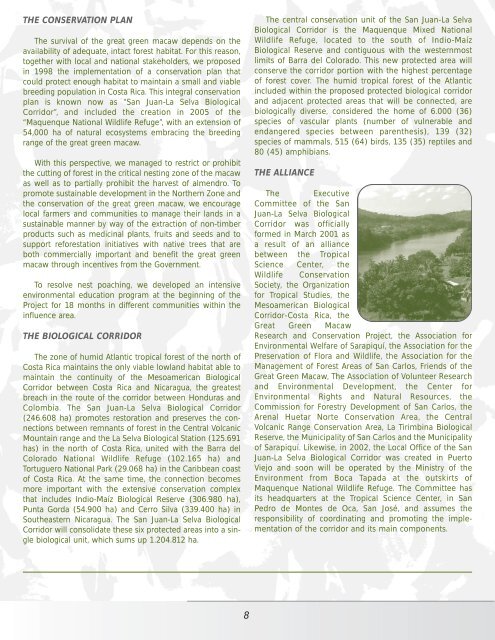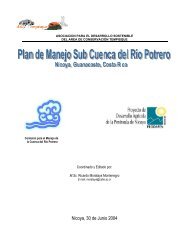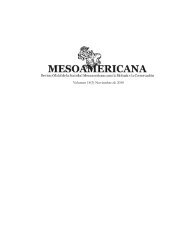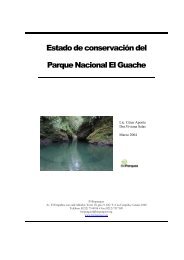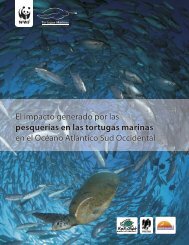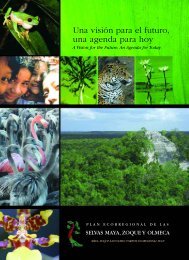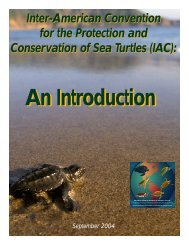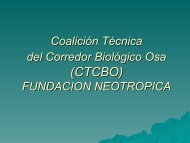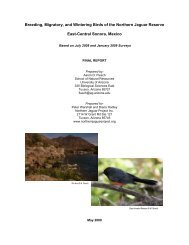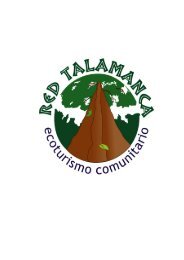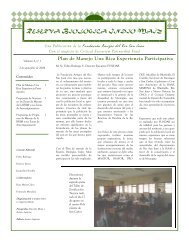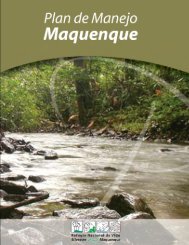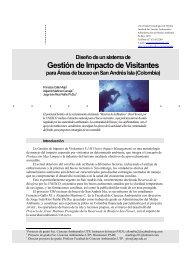1994-2006 - Eco-Index
1994-2006 - Eco-Index
1994-2006 - Eco-Index
You also want an ePaper? Increase the reach of your titles
YUMPU automatically turns print PDFs into web optimized ePapers that Google loves.
THE CONSERVATION PLAN<br />
The survival of the great green macaw depends on the<br />
availability of adequate, intact forest habitat. For this reason,<br />
together with local and national stakeholders, we proposed<br />
in 1998 the implementation of a conservation plan that<br />
could protect enough habitat to maintain a small and viable<br />
breeding population in Costa Rica. This integral conservation<br />
plan is known now as “San Juan-La Selva Biological<br />
Corridor”, and included the creation in 2005 of the<br />
“Maquenque National Wildlife Refuge”, with an extension of<br />
54,000 ha of natural ecosystems embracing the breeding<br />
range of the great green macaw.<br />
With this perspective, we managed to restrict or prohibit<br />
the cutting of forest in the critical nesting zone of the macaw<br />
as well as to partially prohibit the harvest of almendro. To<br />
promote sustainable development in the Northern Zone and<br />
the conservation of the great green macaw, we encourage<br />
local farmers and communities to manage their lands in a<br />
sustainable manner by way of the extraction of non-timber<br />
products such as medicinal plants, fruits and seeds and to<br />
support reforestation initiatives with native trees that are<br />
both commercially important and benefit the great green<br />
macaw through incentives from the Government.<br />
To resolve nest poaching, we developed an intensive<br />
environmental education program at the beginning of the<br />
Project for 18 months in different communities within the<br />
influence area.<br />
THE BIOLOGICAL CORRIDOR<br />
The zone of humid Atlantic tropical forest of the north of<br />
Costa Rica maintains the only viable lowland habitat able to<br />
maintain the continuity of the Mesoamerican Biological<br />
Corridor between Costa Rica and Nicaragua, the greatest<br />
breach in the route of the corridor between Honduras and<br />
Colombia. The San Juan-La Selva Biological Corridor<br />
(246.608 ha) promotes restoration and preserves the connections<br />
between remnants of forest in the Central Volcanic<br />
Mountain range and the La Selva Biological Station (125.691<br />
has) in the north of Costa Rica, united with the Barra del<br />
Colorado National Wildlife Refuge (102.165 ha) and<br />
Tortuguero National Park (29.068 ha) in the Caribbean coast<br />
of Costa Rica. At the same time, the connection becomes<br />
more important with the extensive conservation complex<br />
that includes Indio-Maíz Biological Reserve (306.980 ha),<br />
Punta Gorda (54.900 ha) and Cerro Silva (339.400 ha) in<br />
Southeastern Nicaragua. The San Juan-La Selva Biological<br />
Corridor will consolidate these six protected areas into a single<br />
biological unit, which sums up 1.204.812 ha.<br />
The central conservation unit of the San Juan-La Selva<br />
Biological Corridor is the Maquenque Mixed National<br />
Wildlife Refuge, located to the south of Indio-Maíz<br />
Biological Reserve and contiguous with the westernmost<br />
limits of Barra del Colorado. This new protected area will<br />
conserve the corridor portion with the highest percentage<br />
of forest cover. The humid tropical forest of the Atlantic<br />
included within the proposed protected biological corridor<br />
and adjacent protected areas that will be connected, are<br />
biologically diverse, considered the home of 6.000 (36)<br />
species of vascular plants (number of vulnerable and<br />
endangered species between parenthesis), 139 (32)<br />
species of mammals, 515 (64) birds, 135 (35) reptiles and<br />
80 (45) amphibians.<br />
THE ALLIANCE<br />
The Executive<br />
Committee of the San<br />
Juan-La Selva Biological<br />
Corridor was officially<br />
formed in March 2001 as<br />
a result of an alliance<br />
between the Tropical<br />
Science Center, the<br />
Wildlife Conservation<br />
Society, the Organization<br />
for Tropical Studies, the<br />
Mesoamerican Biological<br />
Corridor-Costa Rica, the<br />
Great Green Macaw<br />
Research and Conservation Project, the Association for<br />
Environmental Welfare of Sarapiquí, the Association for the<br />
Preservation of Flora and Wildlife, the Association for the<br />
Management of Forest Areas of San Carlos, Friends of the<br />
Great Green Macaw, The Association of Volunteer Research<br />
and Environmental Development, the Center for<br />
Environmental Rights and Natural Resources, the<br />
Commission for Forestry Development of San Carlos, the<br />
Arenal Huetar Norte Conservation Area, the Central<br />
Volcanic Range Conservation Area, La Tirimbina Biological<br />
Reserve, the Municipality of San Carlos and the Municipality<br />
of Sarapiquí. Likewise, in 2002, the Local Office of the San<br />
Juan-La Selva Biological Corridor was created in Puerto<br />
Viejo and soon will be operated by the Ministry of the<br />
Environment from Boca Tapada at the outskirts of<br />
Maquenque National Wildlife Refuge. The Committee has<br />
its headquarters at the Tropical Science Center, in San<br />
Pedro de Montes de Oca, San José, and assumes the<br />
responsibility of coordinating and promoting the implementation<br />
of the corridor and its main components.<br />
8


